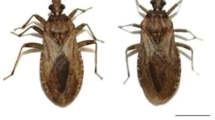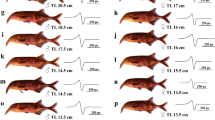Conclusions
-
1)
Hybrids can be made betweenEchinus esculentus andEchinocardium cordatum. The hybrids do not reach a late stage.
-
2)
The only invariable character in the early plutei is the aboral process of theEchinocardium larva, which is completely absent The Inheritance of the Aboral Process of the Echinocardium-Pluteus. 567 inEchinus. The other early larval characters are subject to a considerable amount of variation, especially under unfavourable circumstances and this variation overlaps in the two forms.
-
3)
In the crossEchinus ♀ XEchinocardium ♂ all the larvae inherit the absence of the aboral process from the female parent.
-
4)
In the crossEchinocardium ♀ XEchinus ♂ the majority of the larvae are unhealthy and have the paternal absence of an aboral process. Among these are a few healthy larvae, which develop the maternal aboral process. When the paternal character dominates, it seems to give unhealthy hybrids.
Zusammenfassung
-
1)
ZwischenEchinus esculentus undEchinocardium cordatum ist Bastardierung möglich. Die Bastarde erreichen kein spätes Stadium.
-
2)
Der einzige unvariable Charakter bei den Pluteis frühen Stadiums ist der aborale Fortsatz derEchinocardium-Larve, welcher beiEchinus vollständig fehlt. Die andern frühen Larvencharaktere sind großer Variabilität unterworfen, speziell unter ungünstigen Bedingungen, und diese Variabilität greift auf beide Arten über.
-
3)
Bei der KreuzungEchinus ♀ XEchinocardium ♂ erben alle Larven das Fehlen des aboralen Fortsatzes vom weiblichen Teil.
-
4)
Bei der KreuzungEchinocardium ♀ XEchinus ♂ ist die Mehrzahl der Larven ungesund und zeigt wie der Vater Abwesenheit des aboralen Fortsatzes. Außer ihnen gibt es eine Anzahl gesunder Larven, die den mütterlichen aboralen Fortsatz entwickeln. Wenn der väterliche Charakter dominiert, scheint er kränkliche Larven zu ergeben.
Similar content being viewed by others
References
Allen, E. J., andNelson, E. W., On the Artificial Culture of Marine Plankton Organisms. Journ. Marine Biol. Assoc. Vol. 7. 1910. p. 421.
Fischel, A., über Bastardierungsversuche bei Echinodermen. Arch. f. Entw.-Mech. Bd. 22. 1906. S. 498.
Fuchs, H. M., On Echinoderm Hybridisation. Report, Brit. Ass. Adv. Sci. 1912.
Kupelwieser, H., Entwicklungserregung bei Seeigeleiern durch Molluskensperma. Arch. f. Entw.-Mech. Bd. 27. 1909. S. 343.
MacBride, E. W., Studies in Heredity. I. The Effects of Crossing the Seaurchins Echinus esculentus and Echinocardium cordatum. Proc. Royal Soc. Ser. B. Vol. 84. 1911. p. 394.
Shearer, C., De Morgan, W., andFuchs, H. M., Preliminary Notice on the Experimental Hybridisation of Echinoids. Journ. Marine Biol. Assoc. Vol 9. 1911. p. 121.
- - - On Paternal Characters in Echinóid Hybrids. Quart. Journ. Micr. Soc. Vol. 58. 1912.
Stassano, E., Contr. alla fisiologia degli sperm. Zool. Anz. Bd. 6. 1883. S. 393.
Vernon, H. M., The Relations between the Hybrid and Parent Forms in Echinoid Hybrids. Phil. Trans. Roy. Soc. London. Ser. B. Vol. 190. 1898. p. 465.
Author information
Authors and Affiliations
Rights and permissions
About this article
Cite this article
Fuchs, H.M. The inheritance of the aboral process of the echinocardium-pluteus. Archiv für Entwicklungsmechanik der Organismen 35, 558–568 (1912). https://doi.org/10.1007/BF02277056
Received:
Issue Date:
DOI: https://doi.org/10.1007/BF02277056




